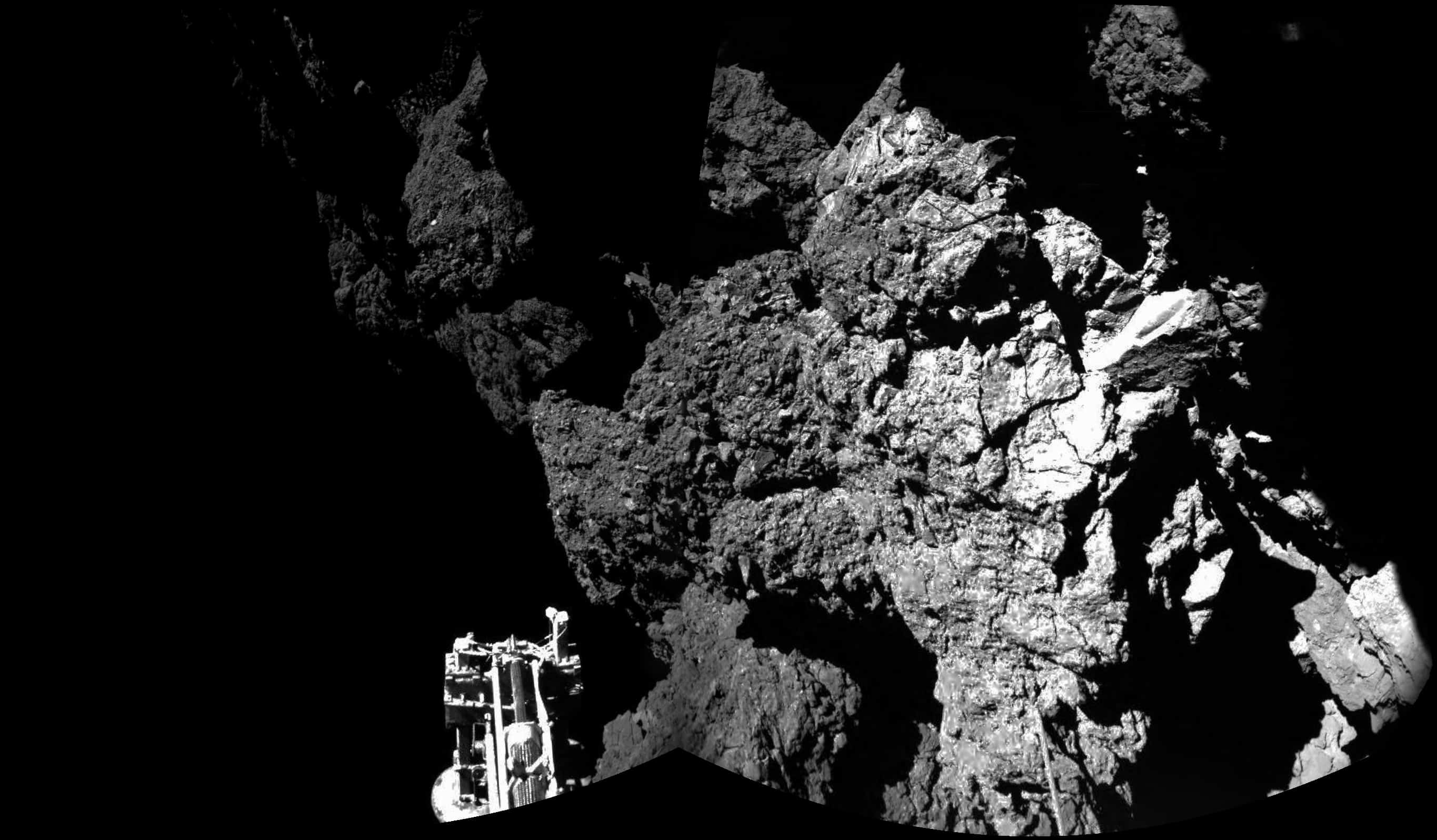
(Courtesy: ESA/Rosetta/Philae/CIVA)
By Tushna Commissariat
It had clearly been a long and busy 24 hours for members of the Rosetta mission at the European Space Agency (ESA) as they gave the latest updates in today’s Google+ Hangout. On Wednesday the mission made history as its “Philae” module touched down safely on the surface of Comet 67P/Churyumov–Gerasimenko. But there has been a great deal of drama and uncertainty since then, as it emerged yesterday that the lander’s final resting spot was more than 1 km away from where it was meant to arrive. Also, Philae is thought to be precariously positioned in the shadows on the far side of a large crater, where its solar panels cannot get enough light to operate as planned. Despite these hurdles, the lander’s many instruments have been functioning well and sending data back to Earth, via the Rosetta orbiter.
Last night, a new set of commands were sent to Philae, including those that activated its Multi-Purpose Sensors for Surface and Subsurface Science (MUPUS) instrument that looks at the thermal and mechanical properties of near-surface layers of Comet 67P. Stephan Ulamec, who is project manager for the lander, says that MUPUS is “hopefully penetrating and hammering into the ground” and that the team has also activated the Alpha Proton X-ray Spectrometer (APXS) that is designed to study what the surface is made of. The Rosetta orbiter has used its Comet Nucleus Sounding Experiment by Radiowave Transmission (CONSERT) radar instrument to scan the comet and hopefully nail down Philae’s location, which has as yet eluded the team. Ulamec has also said that, happily, 80–90% of the scientific experiments that the researchers wanted to carry out have been done already.
Crucially, the researchers activated the drilling mechanism on-board Philae just before the connection with Rosetta and Philae was lost for the day (this is expected and happens whenever the orbiter is below the horizon). While the researchers know that the drill has been active today – according to Philippe Gaudon, CNES Rosetta project manager, the drill extended 25 cm below the base plate – they cannot say for sure if it penetrated the surface, if any samples were taken and analysed, or even if the drilling has jostled Philae out of position already.
As the lander is not tethered to 67P’s surface, any movement such as drilling could send it spinning again or dislodge it. This in itself is a double-edged sword for the mission scientists: on the one hand, the movement may nudge Philae into a better location where its solar panels get more illumination, meaning that it would not go into hibernation when its primary and secondary batteries run out, sometime between tonight and tomorrow. On the other hand, one false move could launch the lander back into space or completely topple it over, damaging the lander and ending its part of the mission altogether.
The team therefore ensured that all of Philae’s other instruments had collected their data before making this risky move that could drastically change the situation on Comet 67P. Indeed, if the drilling does not dislodge it, the team may next consider spinning Philae’s flywheel to make the lander hop into a new spot. Ulamec was quick to point out that it will be very exciting to see what data, if any, will be available tonight at the next planned contact (which will be between 9 p.m. and midnight Central European Time) to see what progress the drilling has made.
Valentina Lommatsch, who was speaking from the DLR Lander Control Center, has said that the team’s battery-power simulations suggest there should be just enough juice left for tonight’s data transmission, but that it will be a very close call. Gaudon pointed out that even if the batteries run out before further communication with Philae tonight, any data the lander has already collected would be saved and could be retrieved at a later date. This could happen in August next year, when the comet will be much closer to the Sun and become “active as hell”, according to Holger Sierks, who is the principal investigator of the Optical, Spectroscopic, and Infrared Remote Imaging System (OSIRIS) on-board the orbiter.
Sierks seemed quite happy with all of the lander’s achievements to date. In fact, he described the CIVA image above – where you can see for the first time a part of Philae (in this case, its foot) actually on the comet – as the “image of [his] life” and said that he gets goosebumps talking about it!
The next few hours will be absolutely crucial and I, along with all of the Rosetta team and millions of others worldwide, will be waiting with baited breath to see how Philae’s story plays out.



